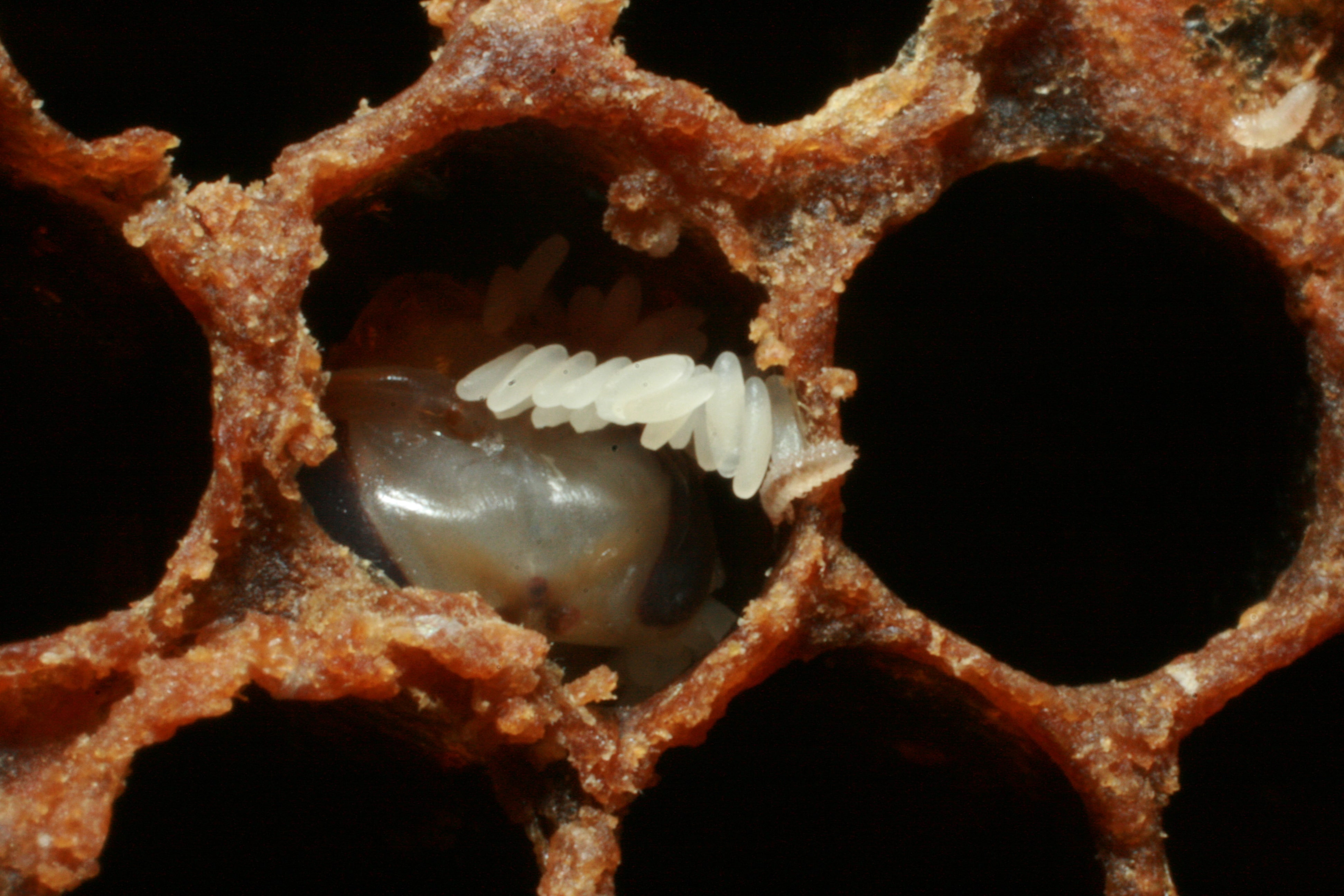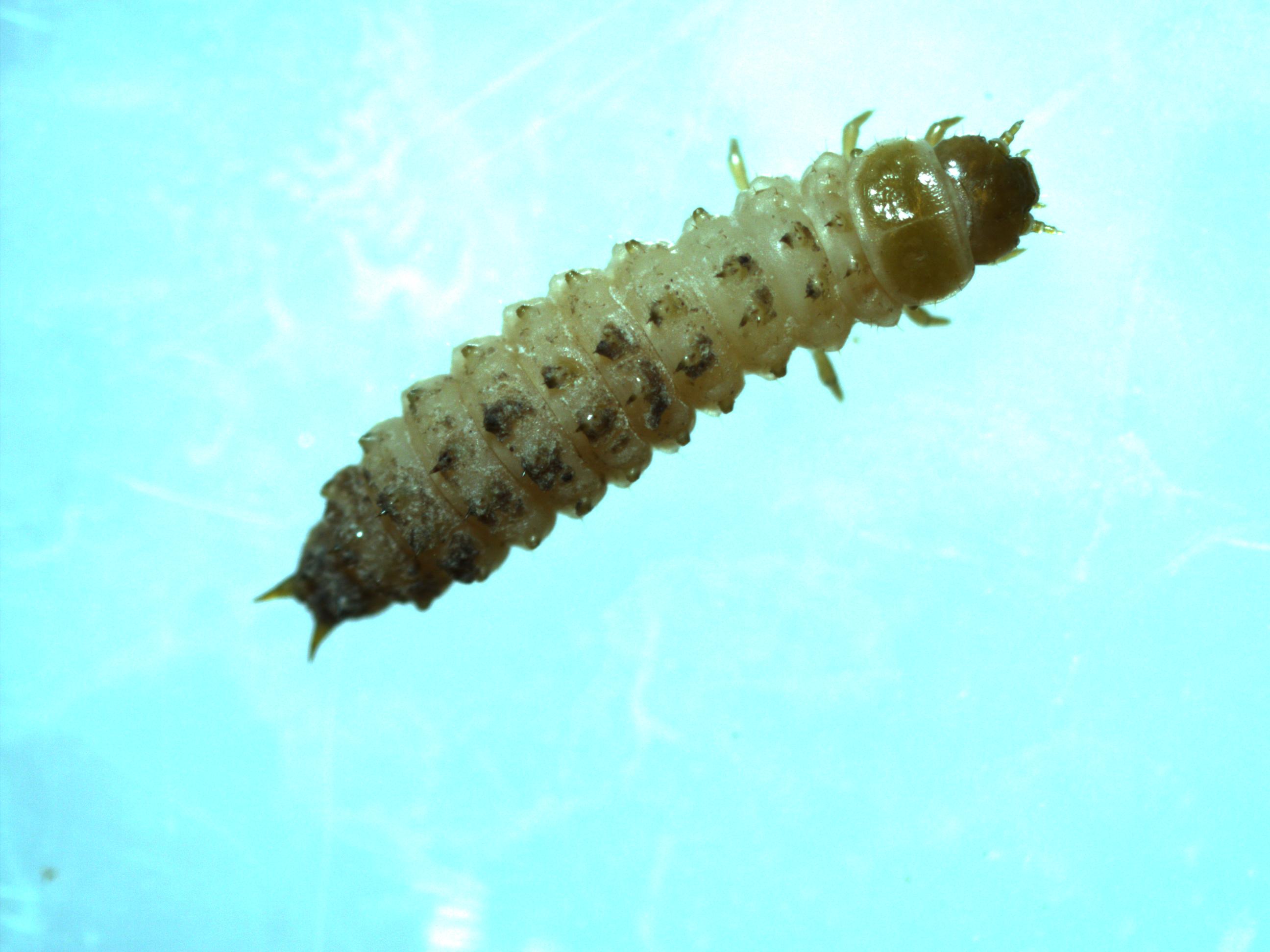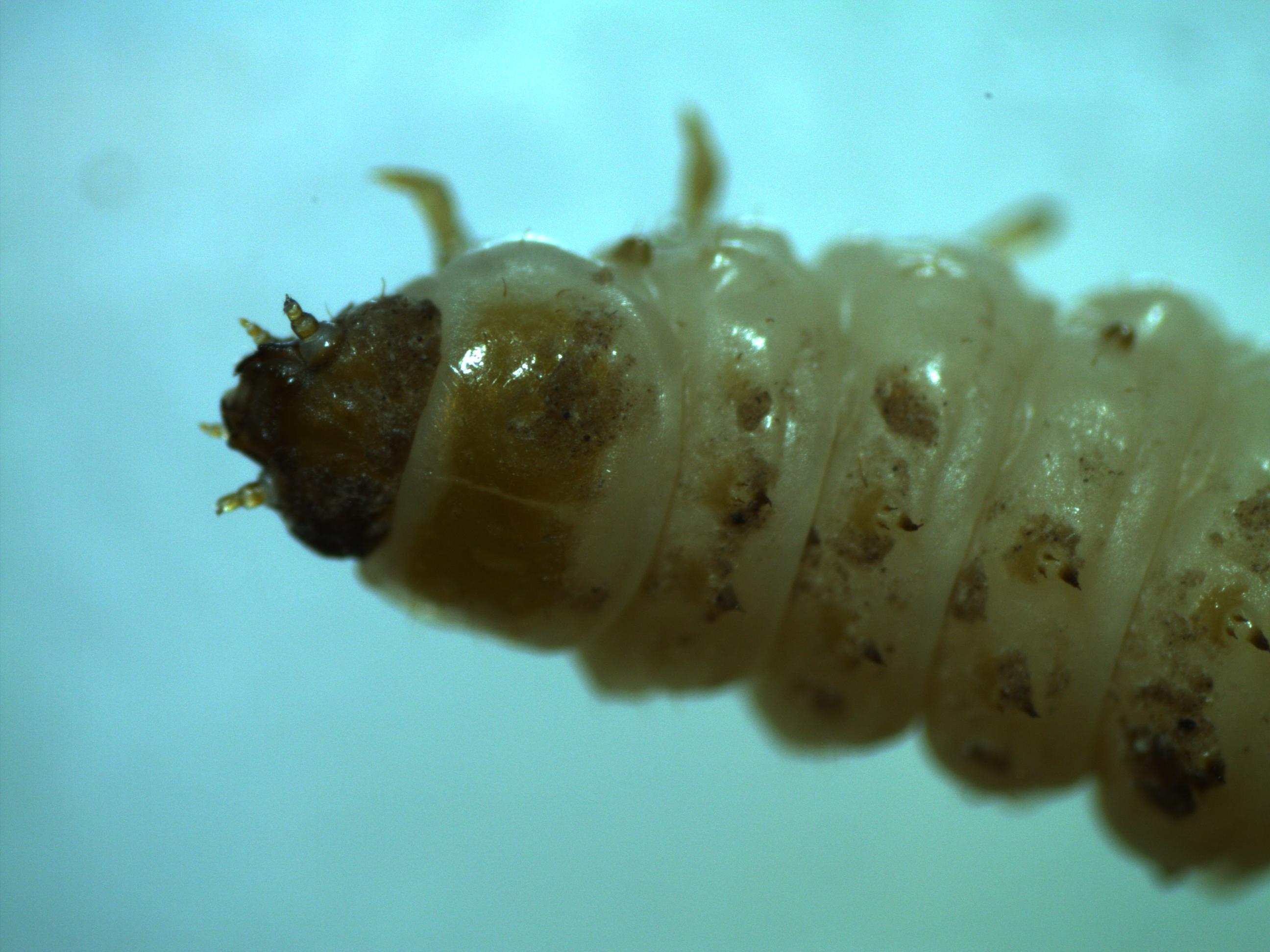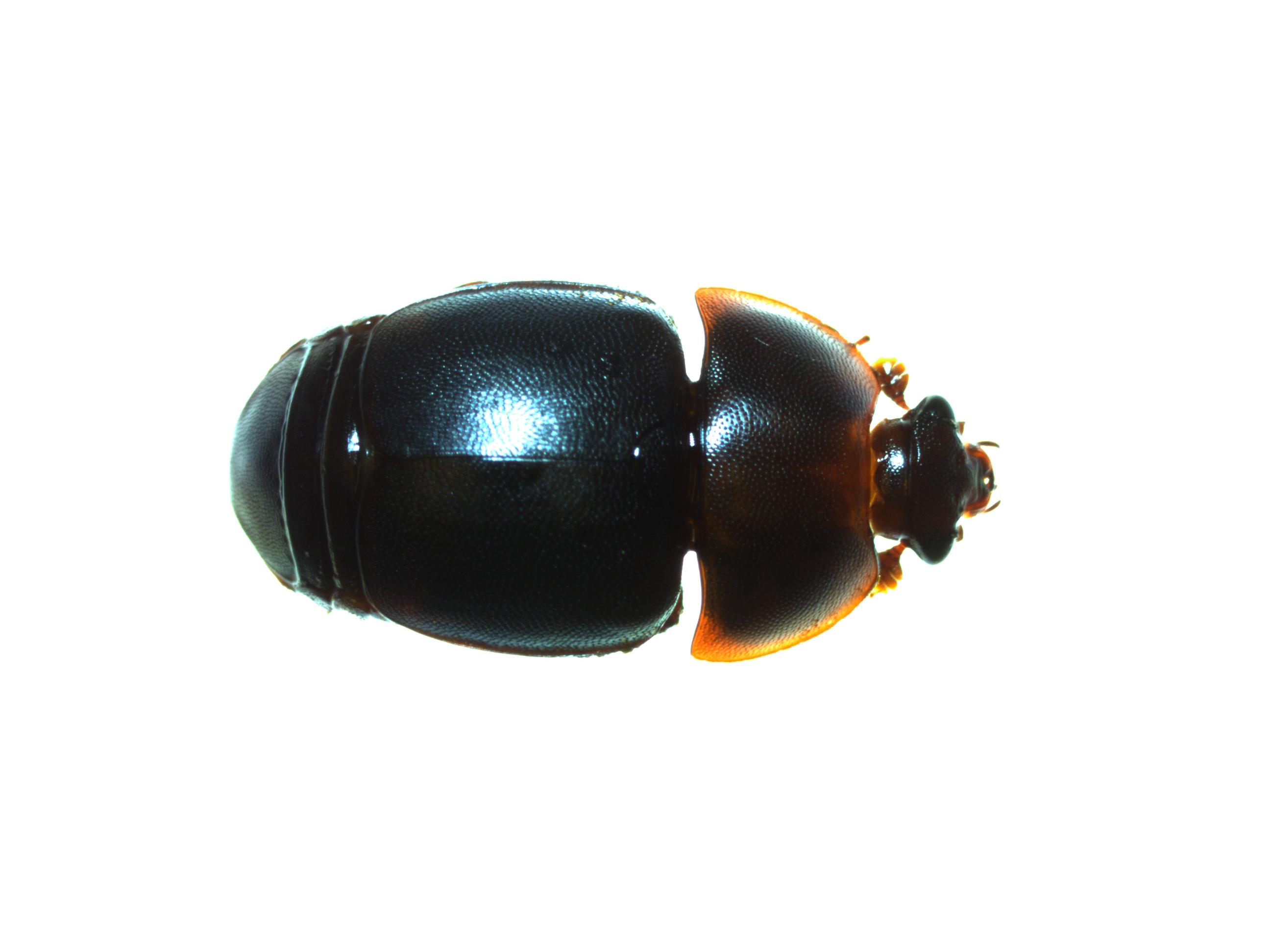Small hive beetle
Information about the small hive beetle (Aethina tumida), a pest of honey bees capable of damaging and stressing colonies.
About small hive beetle
Aethina tumida, or the small hive beetle (SHB), is a honey bee pest that causes honey spoilage as well as damage and stress to colonies under certain conditions. The SHB larvae, not the adult beetles, are primarily responsible for colony damage and honey spoilage. There are no treatments or methods that are guaranteed to eliminate SHB from colonies once present. Managing the pest’s impact depends on the beekeeper’s management practices and environmental conditions.
SHB is present in Ontario, but to date its impact on honey bee colonies has been limited. Typically, in Ontario, SHB larvae have been found at low, non-damaging levels of infestation. When SHB is suspected in an apiary, beekeepers must report this to the Ministry of Agriculture, Food and Rural Affairs' (OMAFRA) Apiary Program.
Life cycle and identification
The SHB is a member of the Nitidulidae ("sap beetle") family. Like other beetles, the SHB goes through complete metamorphosis from egg to larva to pupae to adult. The timing of full development varies from 21 to 94 days depending on environmental conditions such as the local temperature and humidity. Adult SHB will seek out honey bee colonies for shelter, food and as a breeding area for their developing young.
Eggs
- The eggs of the SHB are small (1.4 × 0.26 mm), pearly white and are laid in clusters (Figure 1) in cracks and crevices of the hive.
- Eggs hatch in 3 to 6 days.

Larvae
- Larvae grow to 11 × 1.6 mm before pupation.
- Larvae resemble grubs and are white to beige in color with a brown hardened head, three sets of legs and rows of brown spines along the length of the body (Figures 2 and 3).
- Larvae are typically found clustered together in the cells of honey comb and often immersed in a film of fermented honey.
- After an average of 16 days (may range from 10 to 28 days), the larvae will leave the colony and burrow into the soil to pupate.


The larvae are the most destructive life stage of the SHB in terms of damage to honey bee colonies. Larvae feed on honey bee brood, pollen, honey and tunnel through wax comb consuming protein required for their development. Larvae can cause the honey stored in honey comb to ferment and spoil.
Pupae
- Larvae burrow into soil to pupate for an average of 25 days (may range from 10 to 60 days). Lighter, sandier soils are most suitable for SHB pupation.
- Typically, the larvae will burrow 10 mm deep and approximately 30 mm from the colony entrance. As pupae are located in the soil they are rarely encountered.
Adults
- Adult SHB are reddish brown to black in colour and measure 4-7 × 2-3.5 mm (Figure 4).
- Adult beetles have clubbed antennae, wing coverings that do not extend the full length of the abdomen and a distinct crescent moon shaped structure behind the head.
- Adults may live up to 6 months, can disperse approximately 10 to 14 km by flying and have tremendous reproductive capacity.
- Adults are not restricted to honey bee colonies as they can survive on rotting fruit and can go without food for up to 10 days.
- The adult SHB can overwinter in the honey bee cluster.

Signs of the pest
Larvae and adult beetles can be seen with the naked eye. Larvae are found in the honey comb and the adult beetle can be observed anywhere in the hive.
Adult SHB are typically found in dark, tight spaces in the hive environment, often on the underside of the inner cover, tops of frames and on the bottom board. Adults may also be seen crawling in and out of empty wax cells of the comb. SHB larvae are typically found on the surface of unprotected comb, under pollen patties and on the bottom board.
Signs that may indicate a SHB infestation include:
- clusters of larvae feeding in the comb
- wax comb that has been chewed and tunneled through
- fermented honey running down the surface of the frame, also known as “sliming”
Distribution and spread
The ministry has an online map showing the number of SHB-positive bee yards confirmed in each township. This map not only provides current data to other jurisdictions that import Ontario honey bees, but also informs beekeepers about where SHB has been detected in Ontario, which helps them to manage the risk of infestation of their honey bee colonies.
Spread of SHB through beetle activity
Flying and dispersal
Adult beetles can fly up to distances of 10 to 14 km and several features of SHB biology assist them in their ability to move from one bee yard to another, including:
- very mobile pest with the ability to crawl and fly on their own, separate from honey bees
- long lived and the adults can live separate from honey bees
- may be difficult to detect at lower levels thereby evading detection
- large reproductive capacity under the right conditions
Proximity
The risk of SHB infestation may increase the closer bee yards are situated to the United States border as many of the states adjacent to Ontario have established SHB populations. This is also the case for bee yards adjacent to SHB-positive bee yards and regions in Ontario.
Spread of SHB through beekeeper activity
Purchasing infested honey bee colonies or equipment
The dispersal of adults can be aided by the movement of infested honey bee colonies and beekeeping equipment since selling and purchasing honey bees or used equipment is a common practice in the beekeeping industry. It’s important that selling beekeepers are diligent in inspecting their colonies to detect SHB. It is equally important that purchasing beekeepers purchase from permitted sources. Selling beekeepers must have a valid permit issued by OMAFRA’s Apiary Program prior to any sales of bees or used equipment taking place. Permits are issued by OMAFRA’s Apiary Program only after the inspection requirements are met which helps protect the health of honey bees, particularly from pests and diseases.
Sharing beekeeping equipment among yards and honey houses
When honey bee colonies and materials (such as equipment and frames of brood) are exchanged between locations, pests or disease may also be exchanged and become established in new locations. This can also happen when colonies from numerous bee yards are temporarily amalgamated in the case of overwintering yards (indoor wintering facilities) or moving colonies together (such as pollination).
Swarms
Swarms may be a source of SHB if the swarm originated from an infested colony as SHB can fly with a swarm. Swarms always pose a risk of transferring pests and diseases since there is no way to be certain of the swarm's origin. It is important that beekeepers are aware of the risk that swarms may pose and to examine swarms for pests or disease once they have been installed into standard colony equipment.
Mitigate an infestation
To reduce the likelihood of SHB infestation, minimize damage to honey bee colonies and to prevent the spread of SHB, beekeepers must implement best management practices (BMPs) and adopt routine biosecurity practices.
A number of management activities influence the health, production and population of honey bee colonies. Management practices can and will vary depending on the focus of the beekeeping operation (such as honey production, queen and nucleus production, pollination), but should incorporate basic biosecurity and Essential practices for beekeepers in Ontario (best management practices or BMPs).
Learn about general best management and biosecurity practices for beekeeping in Ontario.
Best management practices
There are specific best management practices for mitigating or reducing the risk of SHB.
Regular colony monitoring
- Engage in routine monitoring using a visual scan underneath the inner cover on the top bars of the frames and in the cells of the wax comb to detect adult SHB
- Larval SHB can be detected underneath pollen patties, in cells of wax comb and amongst debris on the bottom board
- The use of physical traps may assist in detecting SHB
Maintain a clean apiary
- Regularly clean debris from the bottom boards of honey bee colonies
- Keep the apiary clean of wax debris from broken frames or wax scrapings
- Keep colonies and hive equipment in good condition
- Remove and replace old comb, equipment and dead colonies
Maintain strong, healthy and populous honey bee colonies
- Obtain bee stock from an operation with a known honey bee health status
- Reduce potential colony damage or stress by managing other honey bee pests and diseases throughout the beekeeping season
- If treatment for pests or disease is required, choose the appropriate, legally registered treatment and apply according to label instructions
- Ensure nucleus colonies are of sufficient strength, and/or not below a minimum of 3 frames of bees and that there is little to no extra comb space
- Combine 3 way or 2 nucleus colonies into a single standard Langstroth brood box
Take immediate measures to manage weak colonies
- Requeen queenless colonies immediately
- Cull or combine weak honey bee colonies, after assessing these colonies for other pest or disease issues
- Minimize the amount of unprotected comb in proportion to the honey bee population – do not over-super colonies
- Ensure dead bees and unused equipment (especially darker brood comb) are not left exposed in the bee yard
Honey extraction facility best management practices
- Promptly extract honey supers (ideally within 24 to 48 hours). Do not bring more honey supers to the extraction facility than can be extracted within a week.
- Ensure supers are free of bees and SHB (such as using a bee blower) before bringing them to the honey house.
- If possible, manage colonies with queen excluders. If queen excluders are not used, ensure honey bee brood is not brought into the honey house in honey supers.
- Run dehumidifiers in hot rooms to maintain the relative humidity below 50%.
- Maintain a clean honey house, free of debris and wax comb, to reduce attraction to SHB. Ensure that extraction facilities are cleaned after each use.
- Remove unprotected comb, wax cappings and slumgum, or store them in beetle-tight containers. Melt cappings as soon as possible.
- If wax cappings or other materials become infested with SHB, ensure the material is promptly frozen, ideally at -10°C or colder for 24 hours.
- Store honey comb, extracted frames and unused honey supers in a freezer or a cold room (< 10°C) and/or a room with low humidity (< 50% RH).
- Inspect honey combs for damage by the beetle (slimy and/or foul-smelling honey at an advanced stage of fermentation) or the presence of any life stages of the beetle.
If you encounter any SHB larvae, scrape them into a bucket and dispose of them by either burning or freezing.
Biosecurity practices
- Keep vehicle windows and doors closed when visiting a bee yard.
- Before leaving a bee yard and prior to entering a vehicle, conduct a thorough inspection of your bee suit and veil for insects. Remove the bee suit and veil and shake vigorously.
- If visiting a bee yard or location with a greater risk of harbouring SHB, visit this site last during a day of beekeeping activity.
Additional precautions for high-risk areas (in or near known SHB-positive yard)
- Park vehicle 10 meters outside the boundaries of the bee yard. Wash the exterior of vehicle prior to leaving a high-risk area.
- Take only required beekeeping equipment into the bee yard. Use a different set of beekeeping equipment and apparel from yard to yard in a high-risk area.
- Following a visit to an infested bee yard, conduct an inspection of your bee suit and veil. Shake bee suit and veil vigorously and place in a secured bag before entering vehicle. Freeze the bag and the contents for 48 hours before wearing.
Additional precautions for extracting honey supers from a known SHB-positive yard
- Extract SHB-positive yards last.
- Ensure honey supers are placed and stored in a sealed container prior to moving them from the bee yard.
- Freeze honey supers in a sealed container ideally at -10°C or colder for 24 hours prior to honey extraction.
Treatment
Treatment options for SHB include in-hive and outside-of-hive chemical treatments or biological controls. Consult the treatment options for honey bee pests and diseases in Ontario for recommended monitoring methods, treatment methods and timing of treatments for honey bee pests and disease.
If you suspect infestation
Finding a SHB infestation early and taking immediate management action is important to control the pest and prevent its spread within an operation.
If SHB larvae or adults are found in a colony, the beekeeper is to immediately contact their local apiary inspector. It is a requirement of the Ontario Bees Act that beekeepers report this pest. An Apiary Inspector will either inspect the suspect colony or yard or will ask for photos or a specimen to identify or confirm it is SHB.
If you find positive colonies
A colony is considered SHB-positive if adult or SHB larvae are found somewhere in the colony or hive.
A bee yard is considered SHB-positive when one or more colonies in the yard are SHB-positive. A SHB-positive yard remains positive indefinitely.
SHB is not a food safety issue, nor do the beetles kill honey bees. Beekeepers are strongly advised to manage SHB populations in a SHB-positive yard for the success of their apiary at large.
Ministry inspectors will require beekeepers to take action on highly infested SHB-positive colonies. Colonies that are SHB-positive are not to be transported. The Bees Act prohibits transport of a named pest, such as SHB. If a beekeeper is eligible for a Queen and Nuc Permit, all SHB-positive yards are listed on the permit. The beekeeper may still sell colonies from a SHB-positive yard but may not sell known SHB-positive colonies.
Non-infested colonies in the yard are at risk of becoming infested with SHB and should be monitored regularly by the beekeeper.
Small hive beetle quarantine revoked in southwestern Ontario
In 2011, the Chief Veterinarian for Ontario established a quarantine area in southwestern Ontario under the Bees Act to limit the spread of small hive beetle by restricting movement of colonies and equipment. The quarantine was successful in slowing the spread of the pest and allowing industry to adapt to its presence.
Since the quarantine was declared, many Ontario beekeepers have learned to manage small hive beetle in their hives. The pest has been identified in different parts of Ontario and has also been found in other Canadian provinces and all bordering states. The province has a multifaceted and collaborative approach in place with industry and researchers to mitigate the spread of small hive beetle and beekeepers have management strategies in place. Small hive beetle does not pose a threat to human, livestock or poultry health. It is also not a food safety risk.
Effective March 14, 2019, the Chief Veterinarian for Ontario revoked the small hive beetle quarantine that was in place for the county of Essex and the municipality of Chatham-Kent. The removal of the quarantine allowed beekeepers with colonies in the quarantine area to resume normal business and hive movement activities, subject to the requirements of the Bees Act.